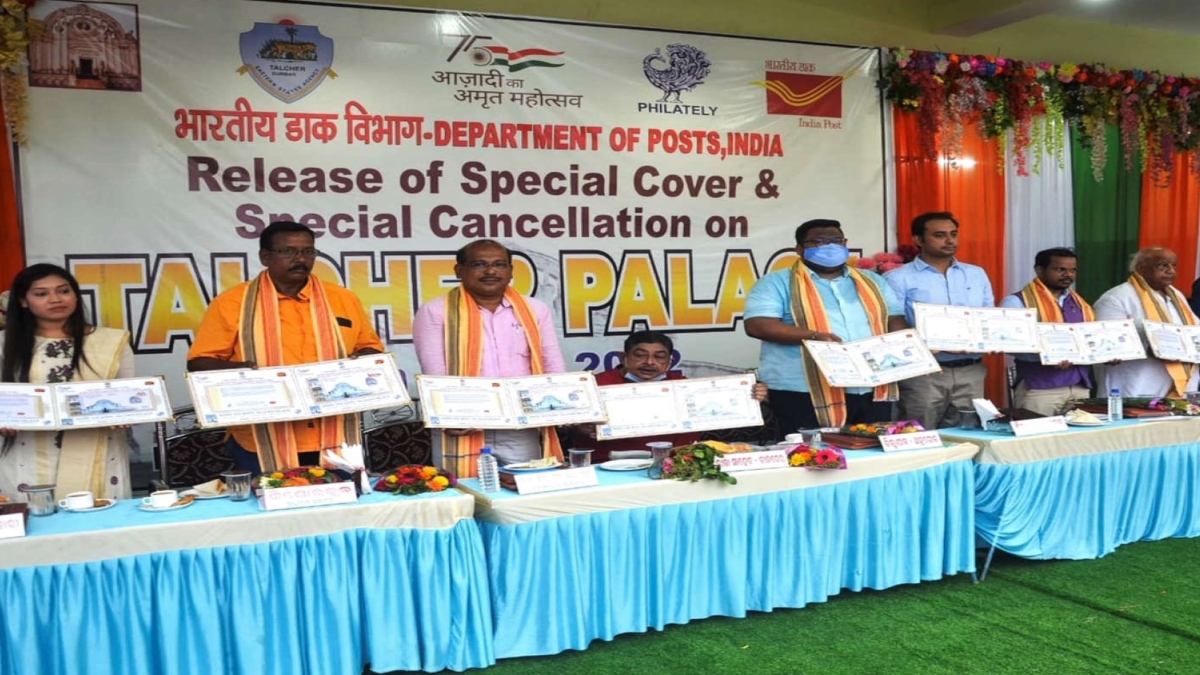


India’s first adhesive stamp, known as the ‘Scinde Dawk’, was introduced in 1852 by Sir Bartle Frere, the Commissioner of Sindh. The production of Indian postage stamps came into the regular curriculum soon after, and the first set of stamps valid for postage throughout the country were placed on sale by 1854. Postage stamps may have been initially created as tokens of mail receipt, but with the passage of time, they took on the additional responsibility of being cultural ambassadors, evolving into visually appealing modes of celebrating national heritage.
 Special Cover and Special Cancellation featuring Talcher Palace.
Special Cover and Special Cancellation featuring Talcher Palace. An old photograph of the Singha Dwar, Talcher Palace.
An old photograph of the Singha Dwar, Talcher Palace. Singha Dwar, the front facade of Talcher Palace.
Singha Dwar, the front facade of Talcher Palace. Release of the Special Cover and Special Cancellation featuring Talcher Palace.
Release of the Special Cover and Special Cancellation featuring Talcher Palace.
In the years following India’s independence, stamps have been effectively used to highlight the nation’s achievements in diverse sectors and showcase its illustrious legacy of art, craft and architecture. Carrying this trend forward, the Department of Posts, Government of India recently commemorated the front façade of Talcher Palace, Odisha by releasing a Special Cover and Special Cancellation featuring its entrance gate known as the ‘Singha Dwar’ or the Lion Gate.
Odisha’s coal city was buzzing with excitement well ahead of this much-awaited occasion. The lanes and by-lanes displayed brightly printed hoardings carrying details of the event, and the local radio made repeated announcements about how it was a moment of pride for all the residents of Talcher that its ‘Rajbati’—the royal residence, was being archived in the philatelic realm.
Expressing his joy on the occasion, Raja Rajendra Chandra Deb of Talcher said, “It is an honour for us that a piece of architecture from our town has been handpicked by the Department of Posts, Government of India. From now on, people across the country will be acquainted with an interesting chapter from Talcher’s history through the medium of this Special Cover and Special Cancellation.”
The event commenced with a powerful warrior dance by the ‘Paikas’—the descendants of the former royal bodyguards, who ceremoniously escorted Raja Rajendra Chandra Deb and Yuvraj Vijayendra Chandra Deb of Talcher to the venue. The unveiling of the Special Cover and Special Cancellation was done by the father-son duo along with the Collector of Angul Siddharth Shankar Swain, veteran political leader Ravi Narayan Pani, Superintendent of Posts Jagdish Das, eminent philatelist Ajit Kumar Rout, and other dignitaries.
Cabinet Minister for Education and Skill Development & Entrepreneurship, Government of India Dharmendra Pradhan, Member of Parliament, Talcher Mahesh Sahoo, and Member of the Legislative Assembly, Talcher Braja Kishore Pradhan also joined the event virtually and sent their best wishes on this occasion.
Addressing the gathering at the event, Yuvraj Vijayendra Chandra Deb of Talcher said, “I remember reading in the news a few years ago, how the Department of Posts had released a set of eight commemorative postage stamps featuring the historical gates of regal India like the Jorawar Singh Gate in Jaipur, Kote Gate Bikaner, etc. I am delighted to see our Singha Dwar joining the company of such magnificent structures.”
‘Singha Dwar’ was built by Raja Ram Chandra Birabar Harichandan of Talcher between 1868 and 1875 under a famine relief scheme to provide ‘food and employment with dignity’ to the people of this region. Like all Indian famines of the 19th Century, this one was also preceded by drought. The population of the region largely depended on the rice crop for sustenance, but an early and scanty monsoon broke their backs. Moreover, the casual export of food grains under the British regime and lack of prompt action towards crises management further aggravated this outbreak. In order to battle this crisis, the benevolent ruler of Talcher along with his advisors rose to the occasion, and came up with the plan to construct the ‘Singha Dwar’. This created an earning opportunity for the farmers as well as for all the others in need, aiding the resurrection of the socio-economic structure of this area.
As for the architectural aspects of this seventy feet tall monument, there are two lion statues standing imposingly on either side of the main entrance—a trend commonly found across Odisha at the entrance of temples and royal residences. There is a wheel with fourteen spokes at the centre that could possibly be inspired by the Konark Temple. The crescent-shaped structure right on top remains the most spectacular element of this monument, invoking a sense of awe among visitors. While this monument is a popular attraction among the people of this region and draws several tourists each day, it witnesses larger crowds during festivals like Dussehra when people pour in great numbers to participate in the ceremonial processions passing through this gate.
For centuries, the dexterous artisans of Odisha have wielded their magic under royal patronage to create magnificent constellations of architecture throughout the state. With the release of this special commemorative cover on Talcher Palace, the Department of Posts has certainly bestowed a well-deserved honour to a glorious structure built on the foundation of philanthropy.
‘Singha Dwar’ was built by Raja Ram Chandra Birabar Harichandan of Talcher between 1868 and 1875 under a famine relief scheme to provide ‘food and employment with dignity’ to the people of this region.